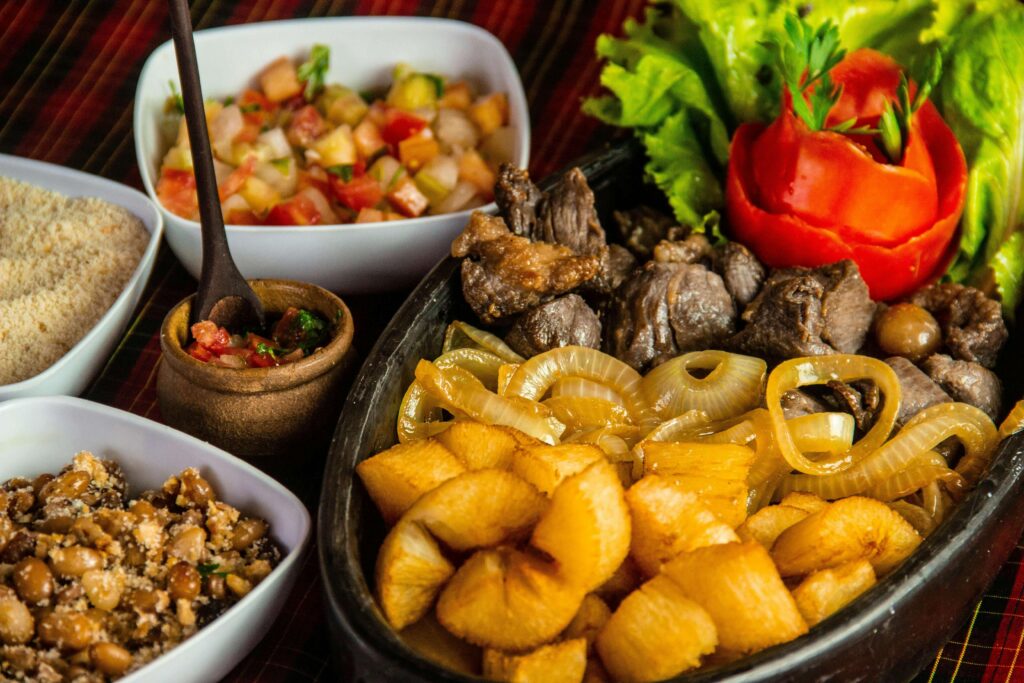Sengalese Feijoada, A West African Twist on a Classic Brazilian Stew is often thought of as a quintessential Brazilian dish, beloved for its hearty, soul-warming qualities. It’s typically a rich stew of black beans, pork, beef, and a medley of spices, slow-cooked to perfection. But did you know that Senegal, a country known for its vibrant culinary heritage, also has its own version of this beloved stew? Senegalese feijoada is a flavorful interpretation that incorporates the same elements of comfort and community, with a unique West African twist.
In this article, we’ll explore what makes Senegalese feijoada special, how it differs from the Brazilian version, and why it’s a must-try dish for anyone seeking bold, complex flavors in their cooking.
The Roots of Feijoada: A Shared Legacy
Feijoada, as a dish, has roots that trace back to Portugal and West Africa, making it a culinary example of cultural fusion. The dish is said to have originated with enslaved Africans in Brazil, who adapted Portuguese bean stews with the ingredients available to them, including pork, beans, and various cuts of meat. Over time, feijoada became a beloved national dish in Brazil, traditionally served with rice, collard greens, and orange slices to balance the richness of the stew.
In Senegal, the influence of West African culinary traditions is evident, particularly in the use of beans, rice, and an array of bold spices. While Senegalese feijoada is not a direct copy of the Brazilian version, it shares some fundamental similarities—slow-cooked beans, meats, and a rich, savory flavor profile—but with a distinct twist that makes it uniquely Senegalese.
What Makes Senegalese Feijoada Different?
While both the Brazilian and Senegalese versions of feijoada are hearty, one-pot meals designed to feed a crowd, Senegalese feijoada incorporates local ingredients and flavors that reflect the region’s diverse food culture. Here are a few key differences and unique elements of Senegalese feijoada:
- Beans and Grains
- While Brazilian feijoada typically uses black beans, Senegalese feijoada often features a variety of beans, with red kidney beans being a popular choice. Beans are an essential part of the diet in West Africa, and they’re often paired with other grains or starchy vegetables like sweet potatoes or yams.
- In addition to beans, rice plays a central role in many Senegalese dishes, so it’s common to serve the stew with a side of fluffy white rice, or sometimes even mix it into the stew itself.
- Meats
- The protein in Senegalese feijoada can include a variety of meats, including beef, goat, chicken, or even fish, depending on what’s available. In contrast, the Brazilian version is primarily focused on pork, using cuts like pork shoulder, sausages, and smoked meats. While both versions are typically cooked with smoked meats to enhance the flavor, Senegalese feijoada may include more lamb or beef-based options.
- Another unique addition in Senegalese feijoada is the use of dried fish or smoked fish, which imparts a distinct depth of flavor and a nod to Senegal’s rich coastal and fishing traditions.
- Spices and Seasonings
- The seasoning in Senegalese feijoada leans heavily on the use of traditional African spices, such as ginger, garlic, onions, and cumin. Another key ingredient is attieke (fermented cassava), which may be added to the broth for a slightly sour, tangy flavor.
- The dish also often features hot peppers for a bit of heat, alongside the aromatic use of herbs like bay leaves and thyme. These bold flavors make the Senegalese version spicier and more aromatic than the Brazilian version, which tends to focus more on the richness of the meat and beans.
- Vegetables
- Vegetables play a more prominent role in Senegalese feijoada, which often includes hearty root vegetables like carrots, sweet potatoes, and sometimes plantains. These vegetables help to balance the richness of the meats and add natural sweetness and texture to the stew.
- Serving Style
- In Senegal, feijoada is typically served with a side of attieke, a dish made from fermented cassava that’s similar to couscous. This starchy side dish balances the stew’s deep, savory flavors and adds a little tang. In order to provide a crisp contrast to the richness of the stew, feijoada is also frequently served with a straightforward salad of tomatoes, onions, and cucumber.

How to Prepare Feijoada in Senegal
Making Senegalese feijoada is a labor of love, and it requires patience as the ingredients slowly come together to form a rich, flavorful dish. Here’s a basic recipe to get you started:
Ingredients:
- 1 lb beef (stew meat, oxtail, or goat)
- 1 lb smoked sausage or smoked fish
- 2 cups red kidney beans (or your choice of beans)
- 1 medium onion, chopped
- 3 cloves garlic, minced
- 1-2 hot peppers (optional, to taste)
- 1 large carrot, diced
- 2 sweet potatoes, peeled and cubed
- 1 tbsp ginger, minced
- 1 tsp ground cumin
- 1 tsp thyme
- 1 bay leaf
- 4 cups beef or chicken broth
- 2 tbsp vegetable oil
- Salt and pepper to taste
- Fresh cilantro, for garnish
- Rice (optional, for serving)
- Attieke or couscous (optional, for serving)
Instructions:
- Prepare the Beans:
-
- Rinse and soak the red kidney beans overnight, or use canned beans for a quicker option. If you’re using dried beans, cook them separately until tender (about 45 minutes).
- Brown the Meat:
- In a large pot, heat the vegetable oil over medium heat. Brown the beef or goat meat on all sides, then remove it from the pot and set it aside. In the same pot, add the smoked sausage or smoked fish and cook for a few minutes to release the flavors.
- Sauté the Aromatics:
- Add the chopped onions, garlic, ginger, and hot peppers to the pot. Sauté for about 5 minutes until softened and fragrant. Add the cumin, thyme, and bay leaf, stirring to coat the ingredients in the spices.
- Add the Broth and Vegetables:
- Bring to a simmer after adding the broth. If you cooked the beans separately, add them along with the sweet potatoes and carrots. Return the browned meats to the pot and simmer gently for 1 to 2 hours to allow the flavors to meld and the stew to thicken.
- Adjust the seasoning by tasting it:
- If necessary, add more salt and pepper after tasting the stew. If you want it hotter, you can add more hot peppers or a small amount of chili flakes.You can add more hot peppers or a tiny bit of chili flakes to make it hotter.
- Provide:
- Garnish the feijoada with fresh cilantro and serve it hot. It’s traditionally served with a side of attieke (fermented cassava couscous) or plain rice.
Why You’ll Love Senegalese Feijoada
- Flavor Complexity: The combination of smoked meats, spices, beans, and root vegetables creates a stew with layers of flavor that’s both rich and comforting. The balance of savory, smoky, spicy, and slightly sweet makes every bite a sensory delight.
- Nutritional Balance: The addition of beans, vegetables, and lean meats makes Senegalese feijoada a well-rounded meal, packed with protein, fiber, and vitamins.
- Cultural Tradition: Like its Brazilian counterpart, Senegalese feijoada is a communal dish meant to bring people together. It’s the kind of meal that invites conversation, sharing, and celebration. Click here for more info
Final Thoughts
Senegalese feijoada offers a beautiful fusion of West African culinary traditions with the slow-cooked goodness of a classic stew. By incorporating local ingredients likesmoked fish, cassava, and root vegetables, this dish offers a unique twist on the beloved Brazilian classic. Whether you’re looking for a hearty family meal or a dish that will transport you to the heart of Senegal, this comforting stew is the perfect choice.
Next time you’re craving something full of flavor, warmth, and tradition, try making Senegalese feijoada. It’s a dish that’s sure to satisfy both your hunger and your sense of adventure







